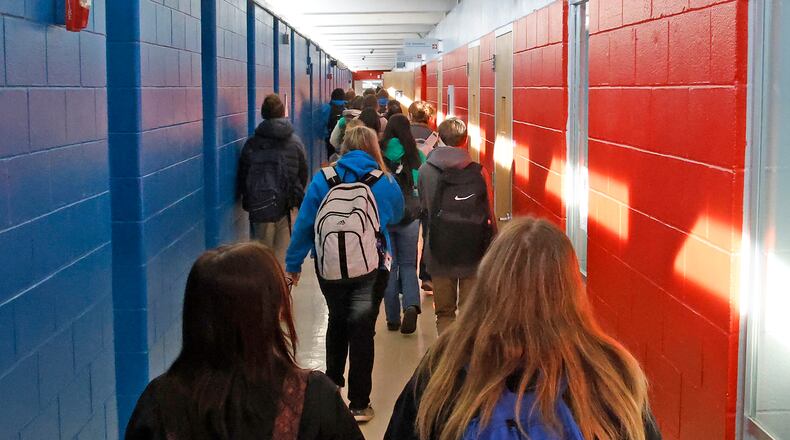“(The levy) is still the same,” said Superintendent Michelle Patrick. “I feel like we learned a lot (from the last election), so I think we’re more hopeful.”
Early voting for the election will start Wednesday, Feb. 21. Election Day is March 19.
The permanent improvement levy is estimated to generate $4,469,000 annually, according to the Clark County Auditor’s Office. It would be $49 a year, or about $4 a month, for a property valued at $100,000.
Patrick wanted to clarify two things about the levy — the cost is on the assessed value of a home and not the market value because “that seemed to be a sticking point for some people misunderstanding and thinking market value was that $100,000,” and the improvements are what’s permanent and not the levy or the tax collection.
The cost of the entire project is expected to be $89,528,662. The total includes the Ohio Facilities Construction Commission (OFCC) contribution of 62%, or about $38.7 million, and CTC’s share of about 38%, or $24.5 million, for the base part of the new building. The levy would raise an additional $26.2 million for items CTC identified as a need, bringing its total to about $50.7 million, including ongoing maintenance funds.
The OFCC provides a portion of state funding for school construction projects that meet its requirements. Approval for the project was given in August 2023, and CTC has 13 months, until September, to come up with its share of the money in order to be granted the state’s portion.
CTC has roughly a 60-year-old campus, among the oldest in the state. It wants to replace its seven existing buildings at 1901 Selma Road with a single, up-to-date facility that would include additional classroom facilities, equipment, furnishings and site improvements needed for additional enrollment.
Supporters said existing buildings are outdated, undersized and fail to meet workforce development needs for today and the future.
The current campus is a little more than 182,000 square feet, and a new facility will add 29,000 square feet, giving them closer to 210,000 square feet. The school currently has nearly 800 students, but turned away more than 700 students between 2013 and 2023 due to the lack of space. That additional space is one of the reasons CTC sought the additional levy money.
The new facility would be built on the current property, south of the administrative building, and far enough away from the existing structures that it wouldn’t interrupt school while it was being built.
Credit: Bill Lackey
Credit: Bill Lackey
Last November, the levy failed with 55.36% (21,684 people) against it and 44.64% (17,488 people) for it.
Patrick said some of what they learned from the last election, aside from clarifying the home value and permanent levy wording, is that their messaging needs to have a wider reach and people still get confused about the school name being CTC instead of JVS, so they added “CTC” to the ballot language.
“(We want to) help people understand we are the old JVS,,” she said.
To help reach more people, they:
— created a facilities and FAQ page on the CTC website,
— sought more speaking engagements with different audiences, groups and organizations, and
— planed open houses for people to walk through and check out the buildings.
“What we’re trying to do is we’re trying to learn from the first election back in November, and we had comments from people about the things that they didn’t really understand,” said Jamie Callan, CTC board president.
Callan said, in addition to Patrick’s points, some people didn’t realize or were not aware the levy was going to be on the ballot.
“If you went with a bond levy, you would have to go with a separate maintenance levy/operating levy to do the maintenance. By doing the permanent improvement, they’re combined together, so you’re only doing one levy,” he said. “That’s the reason we use the permanent improvement description when we did this and some people were under the impression that when you use the word permanent, that means that the tax was going to be there forever, which is not the case.”
Callan added the past campaign signs were “pretty busy” with a lot of information that people couldn’t read when they drove by. They simplified the signs a bit to make them easier to read with more focused information, and they have more of them this time.
“I’m hopeful that the voting public will understand that this is just a fantastic opportunity for the community ... It’s just a great opportunity to add a facility to the community that’s going to make a big difference down the road in providing workers, the kind of workers that we need in the county that were struggling to get right now,” Callan said.
If the levy fails again, Patrick said they would go back to the drawing board, and the school board would have to make a decision about next steps.
Callan said legislation passed allows new districts that are engaged in partnership with the OFCC to have 16 months to pass their levy.
Patrick said: “When we entered that agreement with OFCC, we had 13 (months), so we will double check to see if we need to have it passed within the 13 or if they will allow us to be in the 16 month allowance since it went in affect while we were in the process, and that would give us (until) November.”
Patrick hopes the issue is approved now to take advantage of the state funding.
Callan agreed.
“I am so hopeful that we don’t have to go that route (of going on the ballot again), because when you have to do it three times, you got to find more funding to do the whole levy campaign again ... So that’s why I’m crossing my fingers that we get this done in March,” Callan said.
For more information and FAQs on the levy, visit www.scctc.org/facility-project.
About the Author


